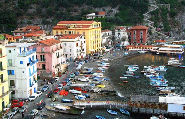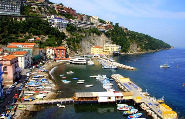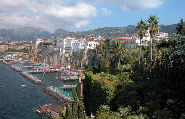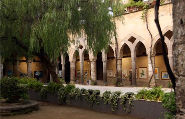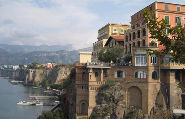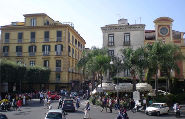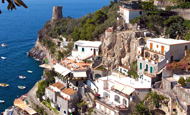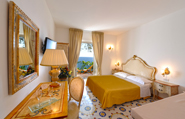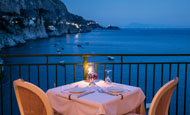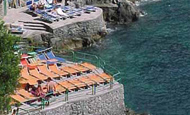SORRENTO
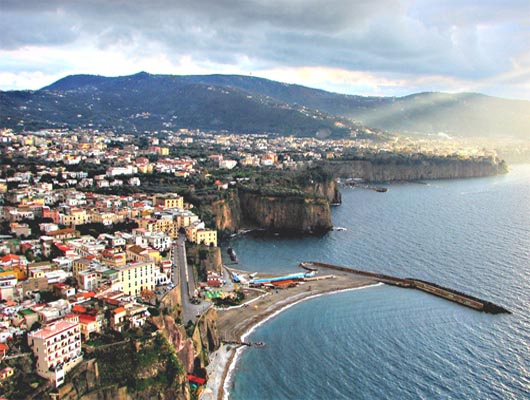
 A splendid and famous holiday resort, Sorrento stands on a terrace rising steeply above the sea on one of
the most spectacular points of the Campanian coast. Because of its enchanting position and
mild climate, sheltered by the surrounding hills, Sorrento has been a favorite resort
since Romans times, (Agrippa, Augustus and Antonius all had villas here) and it became an
elite tourist resort from the eighteenth century, its hotels welcoming such luminaries as
Ibsen, Wagner and Nietzche.
A splendid and famous holiday resort, Sorrento stands on a terrace rising steeply above the sea on one of
the most spectacular points of the Campanian coast. Because of its enchanting position and
mild climate, sheltered by the surrounding hills, Sorrento has been a favorite resort
since Romans times, (Agrippa, Augustus and Antonius all had villas here) and it became an
elite tourist resort from the eighteenth century, its hotels welcoming such luminaries as
Ibsen, Wagner and Nietzche.
The high position above the sea and the consequent absence of a true sea promenade create its extremely original nature. In fact, the port, the Marina Grande and Marina Piccola, picturesque bays with a beach and the harbour, are reached by steps and narrow alleys, which offer panoramic views of incomparable beauty of the coast, the surrounding hills covered in olive-groves and citrus fruit trees, and the crystal-clear sea. Linked to the enchanting beauty of the place is the tradition whereby the name of Sorrento originates from the mythical mermaids whose soft singing tempted Ulysses and his crew in the Odyssey. The site on which the town stands, probably founded by the Greek colonies, was already inhabited in prehistoric times.
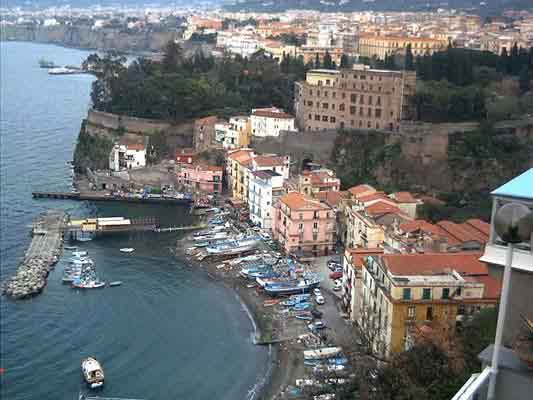 The town is situated at 26Km from
the A3 Napoli-Salerno, with exit at the tollgate of Castellammare di Stabia and proceeding
on the national S.S. 145 Sorrentina.
The town is situated at 26Km from
the A3 Napoli-Salerno, with exit at the tollgate of Castellammare di Stabia and proceeding
on the national S.S. 145 Sorrentina.
The nearest station is the Circumvesuviana on the Sorrento-Napoli line. There are daily
runs to Naples (38 daily runs in summer time and 38 in winter time), to Pompei ruins (38
daily runs in summer time and 38 in winter time) and to the Ercolano ruins (38 in summer
time and 38 in winter time). The town can also be reached by public bus-line of SITA on
the Sorrento-Salerno line with runs to Positano (13 daily runs in summer time and 13 runs
in winter time), to Amalfi (13 daily runs in summer time and 13 runs in winter time) and
to Salerno (12 daily runs in summer time and 12 runs in winter time). It is possible to
get to Sorrento by sea with departures from the dock of Marina Piccola. Connections to
Naples should also be provided (38 daily runs in summer time and 14 daily runs in winter
time), to Capri (33 daily runs in summer time and 33 runs in winter time), to Ischia (8
runs in summer time and 8 runs in winter time).
ARCHITECTURAL ASSETS
DOMINOVA SEAT
Situated in the historical site it is the only remaining testimony in
Campania of the old noble seats and dates back to the XVIth century. It has a
quadrilateral form with two corner arches in pirerno (lava). The end of the walls and the
interior of the cupola (1600) displays XVIIIth century frescoes.
CATHEDRAL IN ROMANIC STYLE
Cathedral of the XVth century. Presents a marble portal (1474) in Renaissance style
surmounted by the Aragonese escutcheon. The church houses an archbishop throne in fine
marbles of 1573, and a wooden marquetry work of Sorrentine craftsmen and of the
Neapolintan school of the 1700s. The Belltower is of the Romanic era (XI cen.) in the
imposing belltower's base.
EX CONVENT OF PADRI TEATINI
The convent today is municipal seat. It is adjacent to the Basilica
dedicated to the Patron Saint ST.Antonino whose remains are conserved in the crypt since
1700. The portal access is in Byzantinian-Romanesque form and dates back to the Xth
century.
CHURCH AND CLOISTER IN SAN FRANCESCO SQUARE
Architectural work of the XIVth century. The cloister's architecture presents crossed
arches in tufo on two sides and on the other two sides round arches on octagonal
pilasters. The church of ST.Francis dates back to the XVI century and in the first of the
three chapels on the right a wooden statue depicting Christ on the criss can be admired.
MUSEUM CORREALE DI TERRANOVA
The ground floor of the museum conserves Greek, Roman and Byzantine marbles. On the upper
floors there are neapolentan furnitures of the '600s and of the '700s, porcellans of
Capodimonte, crystals of Boemia, Venece glasses, pictures and inlaid woodwork collections.
It is possible to visit it from 9am to 12.30am and from 5pm to 7pm excluding Tuesdays.
ARCHEOLOGICAL MUSEUM "VILLA FIORENTINO"
It is possible to visit it from 9am to 7pm
RUINS OF VILLA DI AGRIPPA POSTUMO AND OF PORTA ROMANA
It is possible to visit it from 9am to 7pm
PORTA PARSANO
It is possible to visit them freely.
POLLIO FELICE VILLA
Located in Capo di Sorrento. It is possible to visit it freely.
ART, BUILDINGS AND CHARACTERISTIC PLACES OF SORRENTO
The old town
The only part of the old Greek town still remaining is the defensive wall located under
the road at the Porta Parsano Nuova (new Parsano Gate) and can be viewed through a grid.
Another small ruin of the Greek wall is located at Marina Grande.
The Roman town was built over the Greek one following the same urban plain with walls of
large isodomic blocks.
These walls stood to defend Sorrento through the Middle Ages. Rebuilding began in 1551 and
was only completed in 1561 after the tragic Turkish invasion.
Location: via Sersale corner with via degli Aranci.
Museums
Correale di Terranova Museum
The small museum resulted from the great passion for art by Antonio
Correale, Count of Terranova.
On exhibit are paintings of minor artists of the seventeenth century school of Neapolitan
artists and other artists, among whom is Rubens.
There is also an interesting collection of art objects, neoclassic statues, archiological
diggings, majolicas of local artists, and precious porcelain of Capodimonte.
Location: via Correale.
Historical buildings
Sedile Dominova (Dominova Seat)
This is the only remaining testimony in Campania of the old noble
seats and dates to the XVth century. It has a quadrilateral form with two corner arches in
piperno (lava) permitting the view of the interior of the cupola and the end walls with
18th century frescoes. The pilasters and polystyle arches with their capotals are in
archaic style. The 17th century cupola is formed by green and yellow majolica
roof-tiles.
Location: via S.Cesareo.
Fifteenth Century House
The only curious examples of local architecture deriving
from the influx of Tuscan experts working in Naples in the second half of the 1400s
are the small building with lodge in Vico Galantarario, the capitals which can
be found in Neapolitan staircase in Via S. Arcangelo a Baiano and those of the Pontano
Chapel with the only variation of leaf placed inside out.
Location: via Calantariano.
Part of the House of Tasso
The Imperial Tramontano Hotel incorporates two rooms left from the
house where Torquato Tasso, author of Jerusalem Liberated, was born in 1544
Location: via V.Veneto.
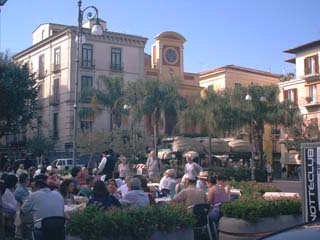 House of Cornelia Tasso
House of Cornelia Tasso
At number 11 Via S. Nicola is the Fasulo House, once the Sersale House.
Cornelia Tasso, Torquato's sister, lived here. Her famous brother lived here too for a
little period. In the entrance hall is a vault decorated with stems, military trophies
and inscriptions from 1615 in memory of the poet.
Location: via S.Nicola, 11.
Correale Palace (XIVth century)
The facade of this building exhibits valuable acute-arched mullioned
windows in dark tufo in various shapes and designs, with small arches and lobed
rose-windows. There is a beatiful large window with an overhanging pointed arch which
rests on polystyle piers upheld by corbers and crowned by Gothic capitals of acanthus
leaves; in the keystone of the arch the coat-of-arms is incised. The portal is
characteristically Neapolitan arch with Durazzesque Catalan patterns and was used from the
1300s all through the 1400s.
Location: via Pietà.
Veniero Palace (XIIIth century)
Despite the alterations which it has undergone over the Centuries this
building is of exceptional raruty and worth as it rapresents the late Byzantine and Arab
faste uniquelly drafted in compositive organic continuity. The three large arched windows
on each floor are surrounded by wide fillets in grey and yellow tufo, two narrower
fillets, used ad floor markers, underline the two rows of windows and round tiles, like
small rose-windows with majolica paterae in the centre, alternate at the apertures with a
slightly raised contour at the base of the plaster. The inlaid tufo decoration develops a
succession of lozanges with the exception of the central window whose frieze follows a
zig-zag motif.
Location: via Pietà.
The Correale House in the Tasso Square
In the main square, once called largo of the castle, exactly at the
corner where Via Pietà begins, another Correale Palace is located. The inscription on the
portal's marble scroll ornament bears the date 1768 but it is known that as early as the
XVth century a house belonging to this family stood here and was later totally transformed
by the 17th century reconstruction.
Location: piazza Tasso.
Porta Seat (XVIth century)
In the corner which Via S. Cesareo forms with the Tasso square, where the
Sorrentine Club is now located, there once stood a Seat, called Porta because it was
originally built near the city's main gate in the area then called Largo del Castello.
After the abolition of the Seats it was first turned into a prison and then a guard-house
for the urban militia and finally a meeting place for the Sorrentine Club.
Location: Tasso square corner with via S.Cesareo.
Churches
The cathedral and the bell tower
The cathedral of Sorrento was built in the eleventh century and
reconstructed in the fifteenth century, continuing the style of Romanesque architecture.
It houses works of Neapolitan artist of the seventeenth century. The cathedral is part of
a complex that hosts the Bishop and has always been considered an important point of
reference for all the Catholic community of the entire peninsula. Of particular interest
is the bell tower with its clock, which is a symbol of the entire structure. Easily
recognized are the elements of the Romanesque period seen on the ground leven of the
buildings, while the circular clock in policromatic ceramic enriches the entire structure.
Location: corso Italia.
Church of the Pietà
The Church stands next to the old monastery and was built in Baroque
style. It was enlarged in 1752 under the Archdeacon Nicolò Cortese as written on the
plaque at the entrance. The shiny stucco walls are adorned by two small temples upheld by
two columns with pictures of St. Francis of Assisi and St. Margeret of Cortone (1600s) in
the centre.
Location: via Pietà.
Church of the Annunciation
The origin of this Church is antique although the date of its foundation
is not known. It was probably built on the remains of the temple dedicated to the godess
Cybele. From 1391 in this church the Agostinian fathers of the congregation of St. John in
Carbonara from Naples officiated. The Church was conceded by their request in 1811 to the
co-patrons of the Chapels on condition that they took on all maintenance expenses.
Location: via Fuoro.
Church and Monastery of St. Paul
The Church is attached to the old monastery of the Benedectine nuns of St.
Paul dating to the IXth century. It consists of one aisle with circular vault and lunettes
and is enriched by decorations, stuccoes, 17th century paintings and a majolica floor over
brickwork. Also noteworthy is the small belvedere belltower and the cupola in majolica.
Location: via Tasso.
Church of the Rosary
Commonly referred to as the St. Rosary it was probably built under the
empire of Costantine the Great (310) over the remains of an old pagan temple called
pantheon. It was Sorrento's cathedral from the XIIth to the XVth century.
Location: via Tasso.
Church of Our Lady of Sorrows
Completed in 1739, it has two unique altairs in local tufo rock. On the
main altar is a 17th century wooden staue reproducing the Virgin of Sorrows. The fasade,
also in tufo, preserves the elegant lines of the 17th century baroque.
Location: via S.Cesareo.





